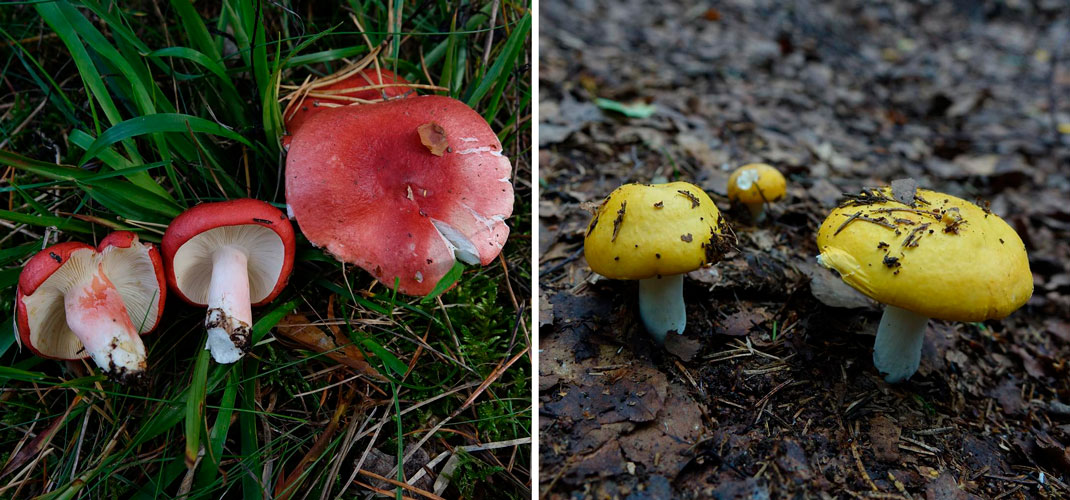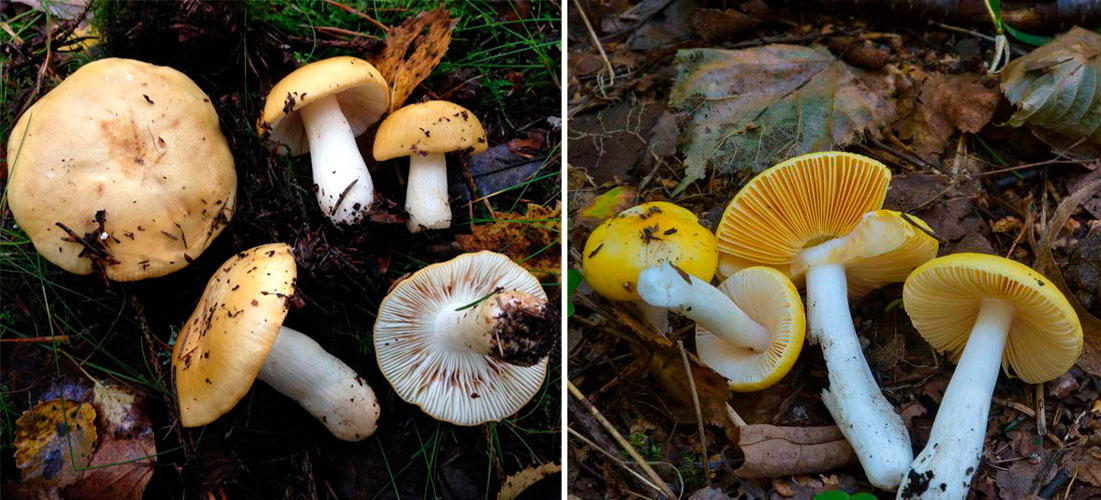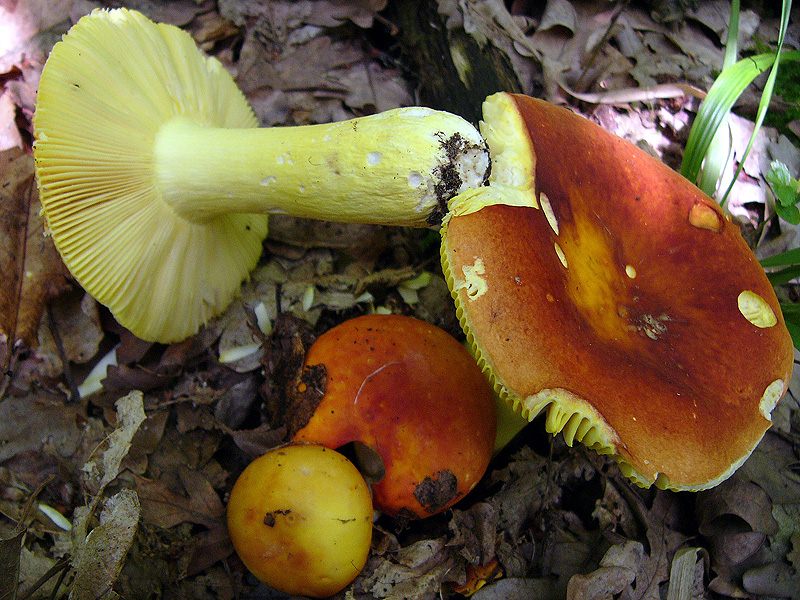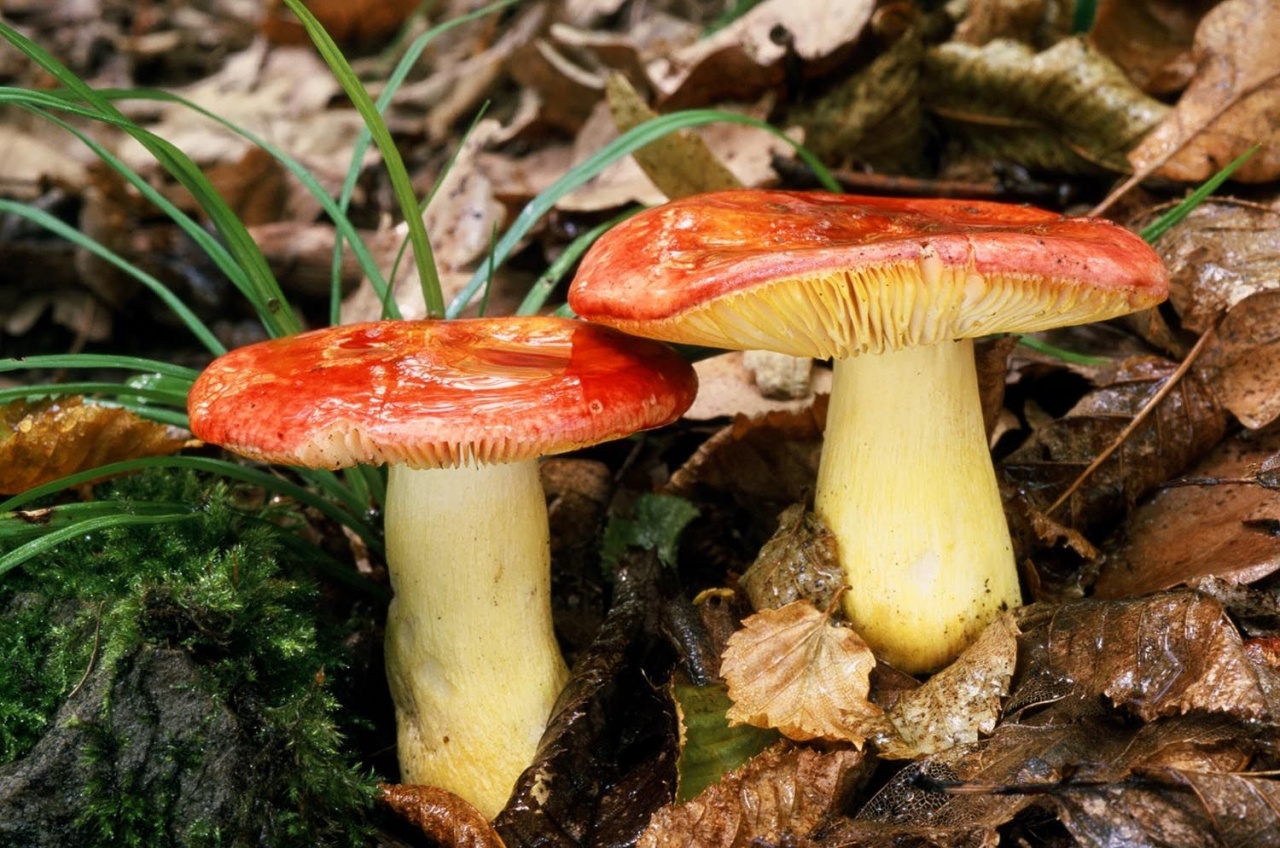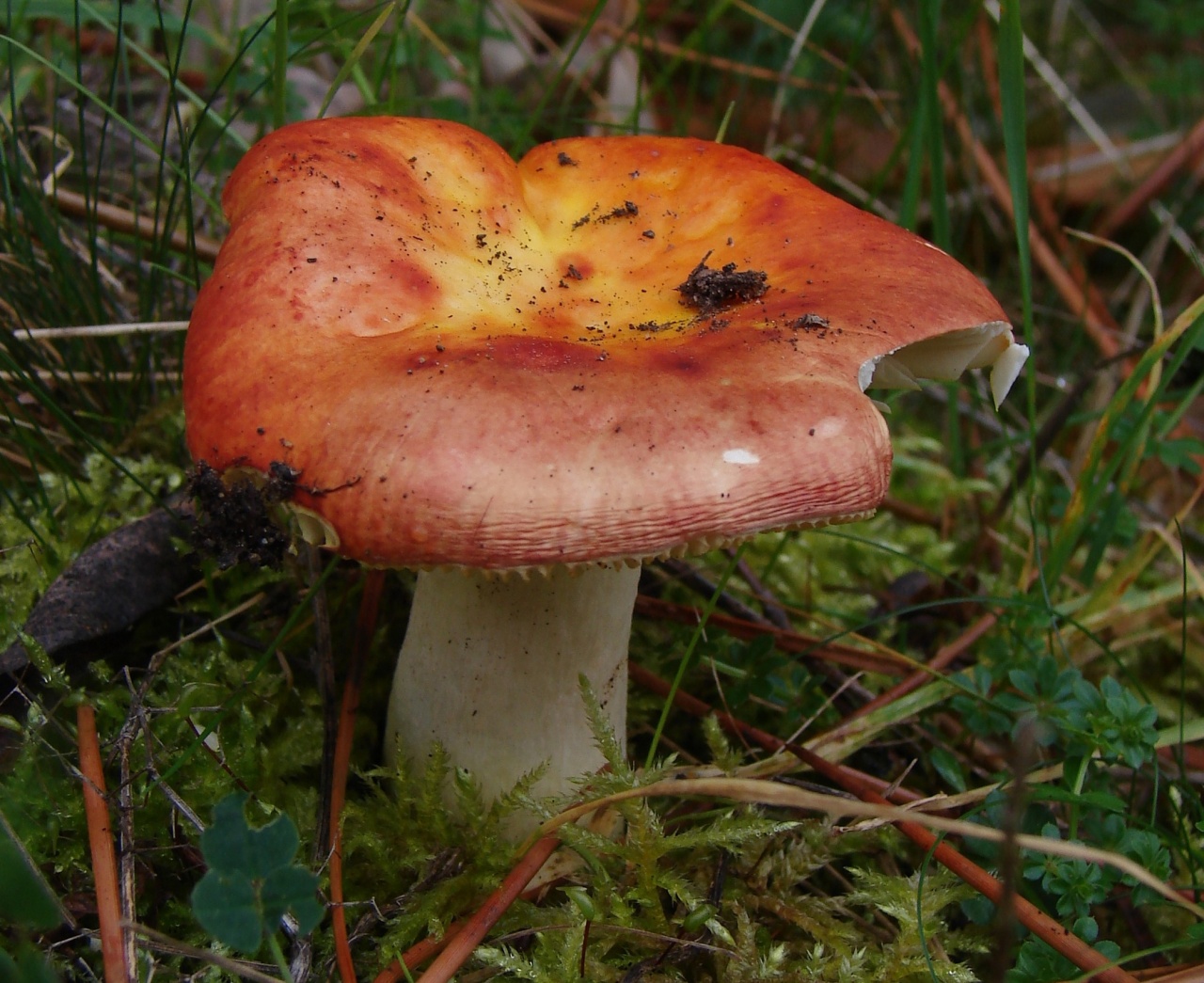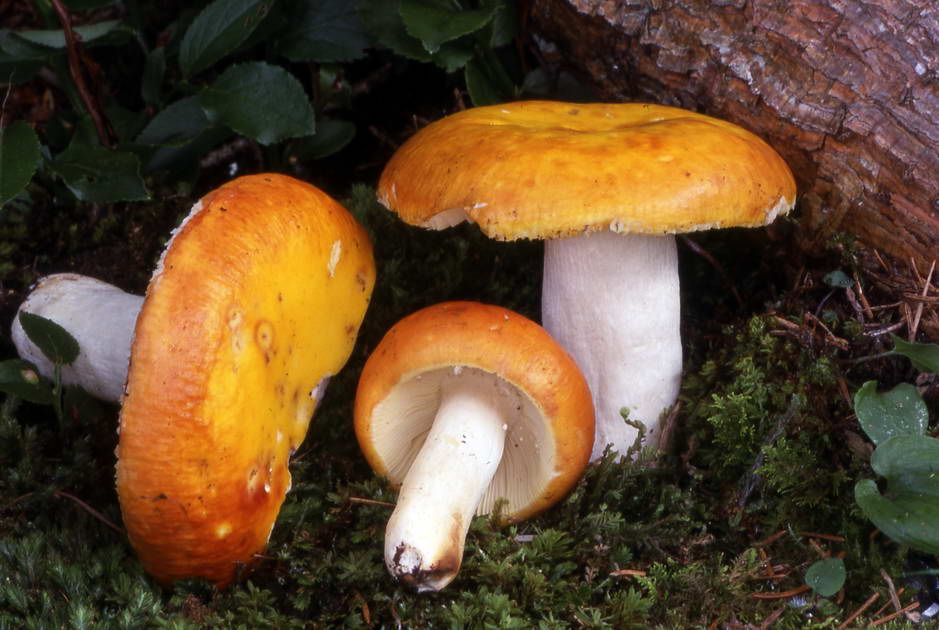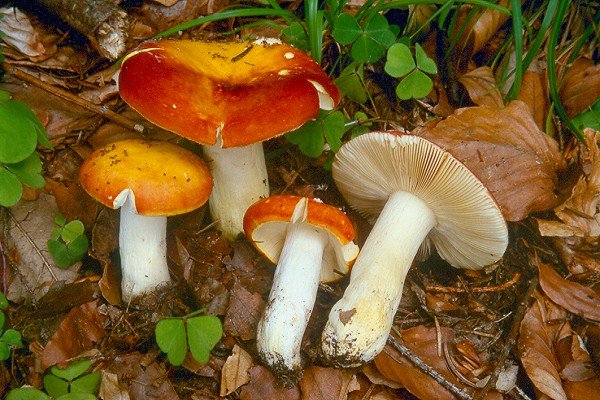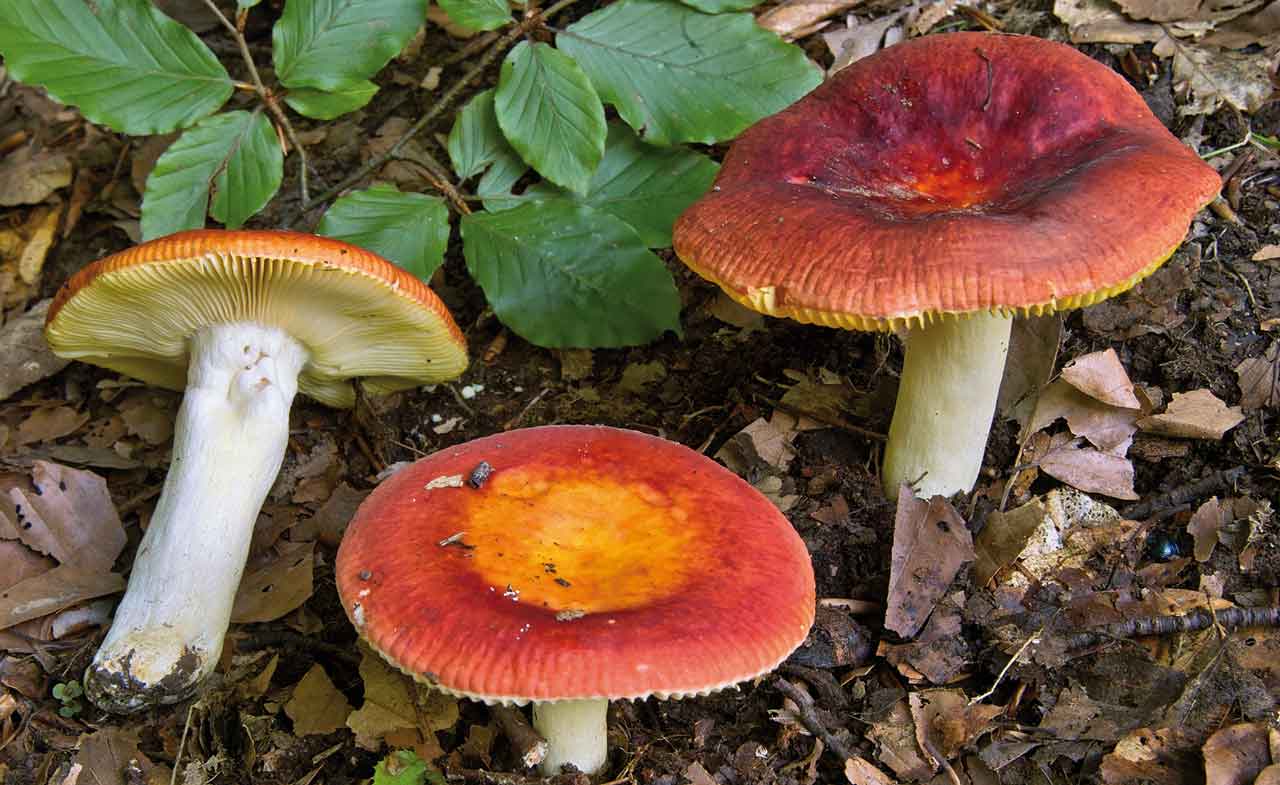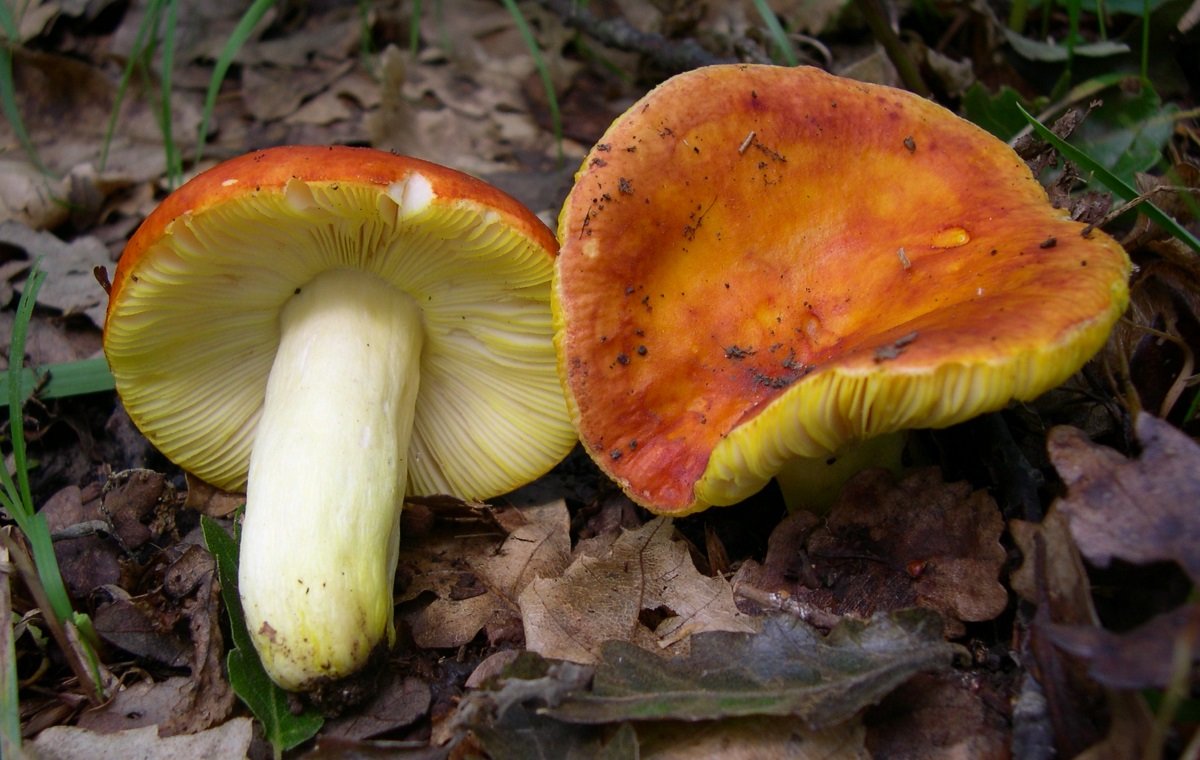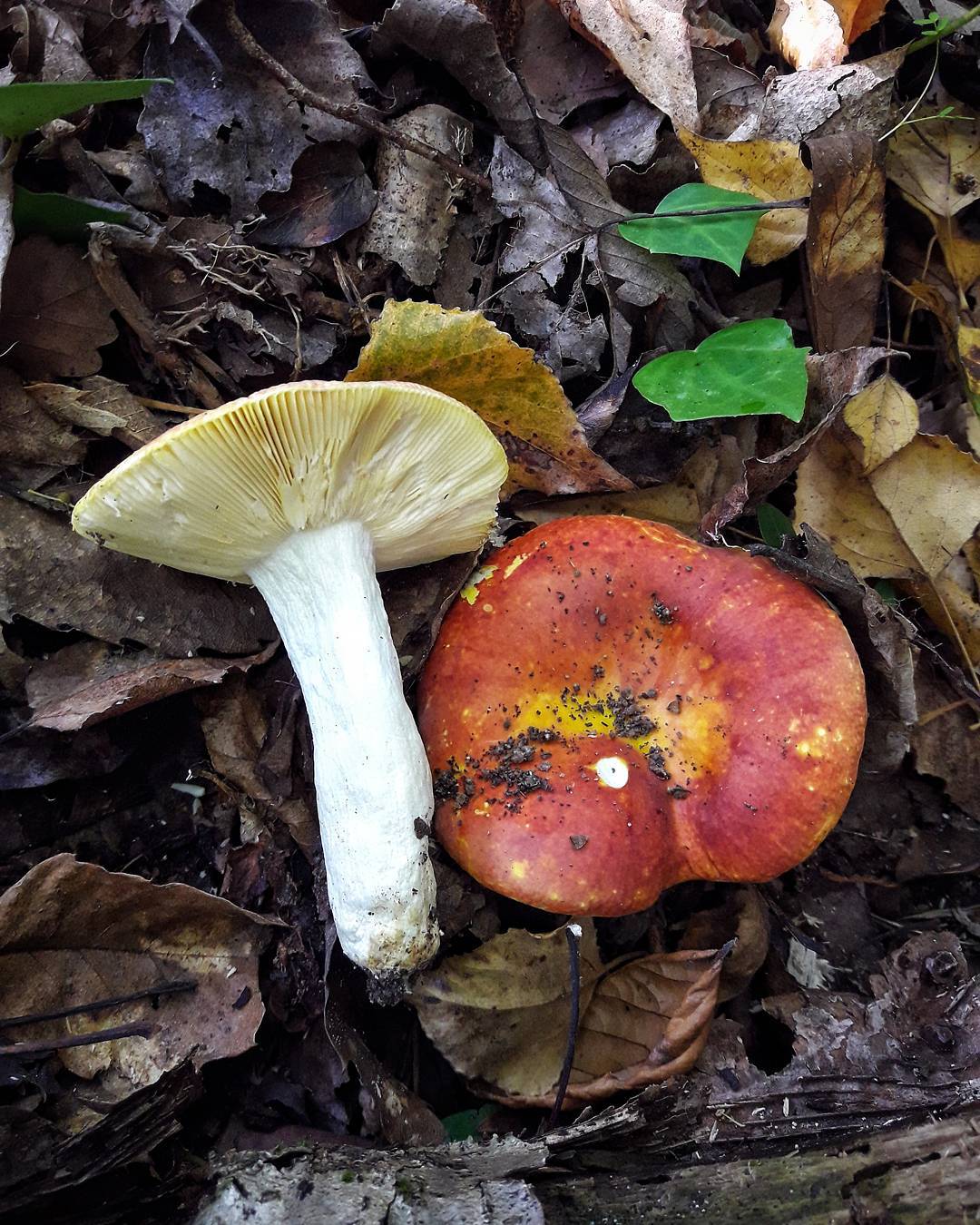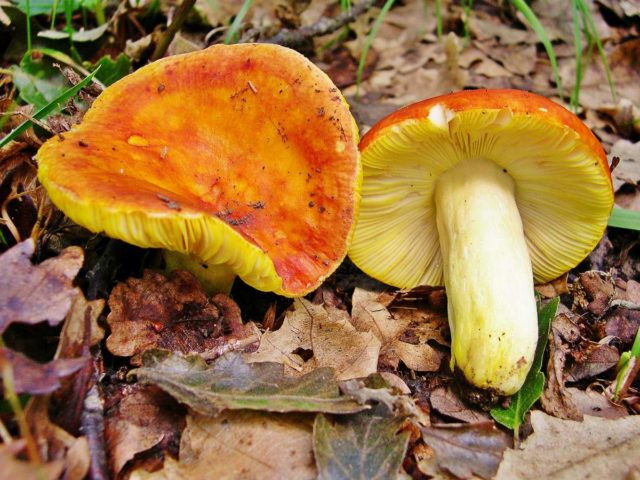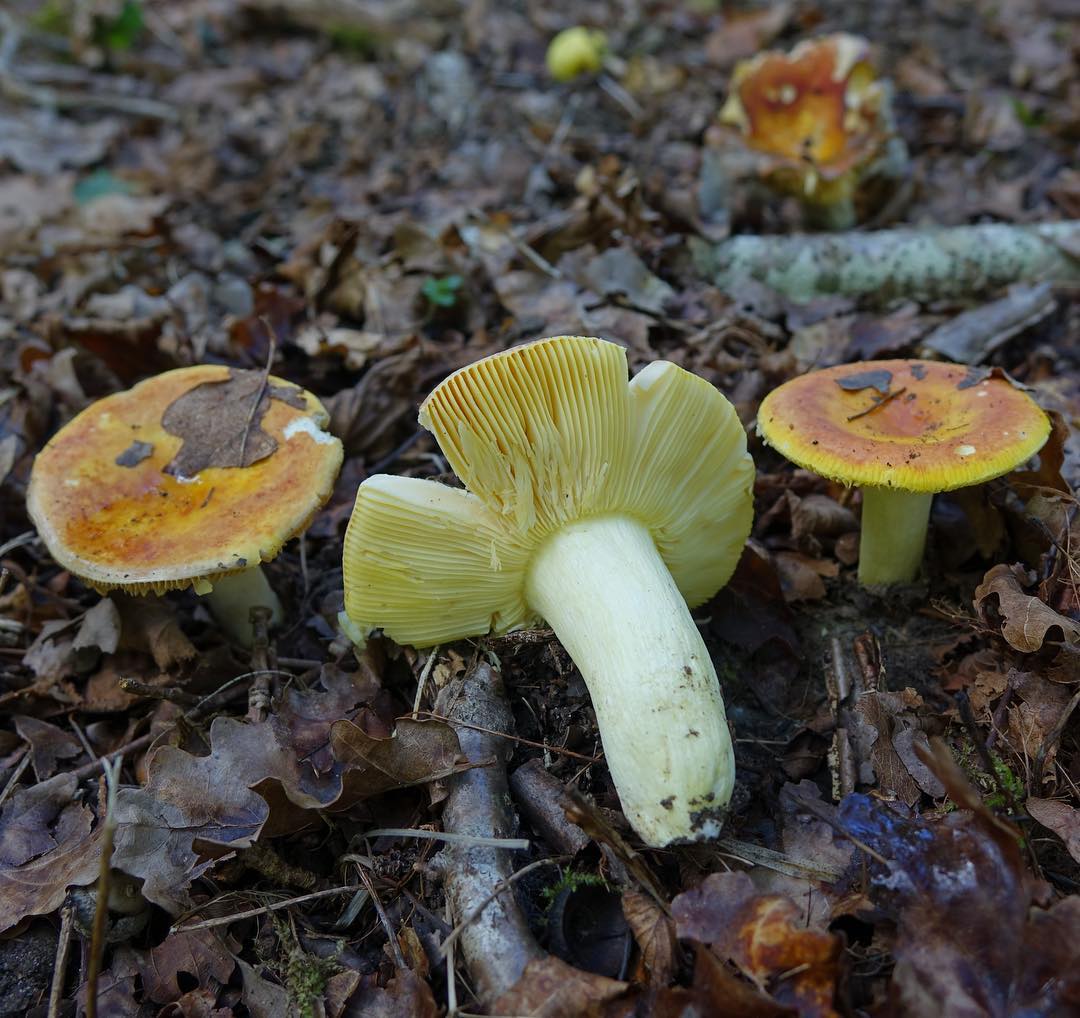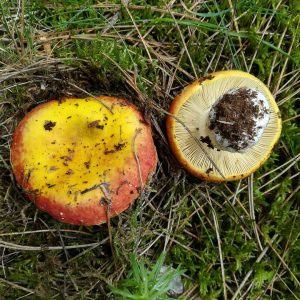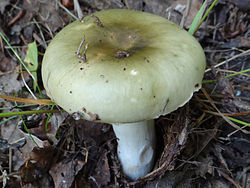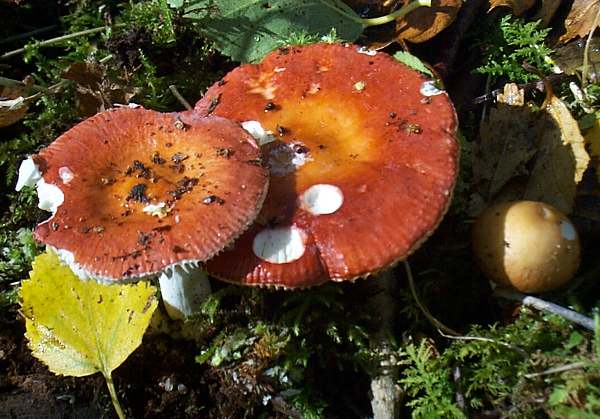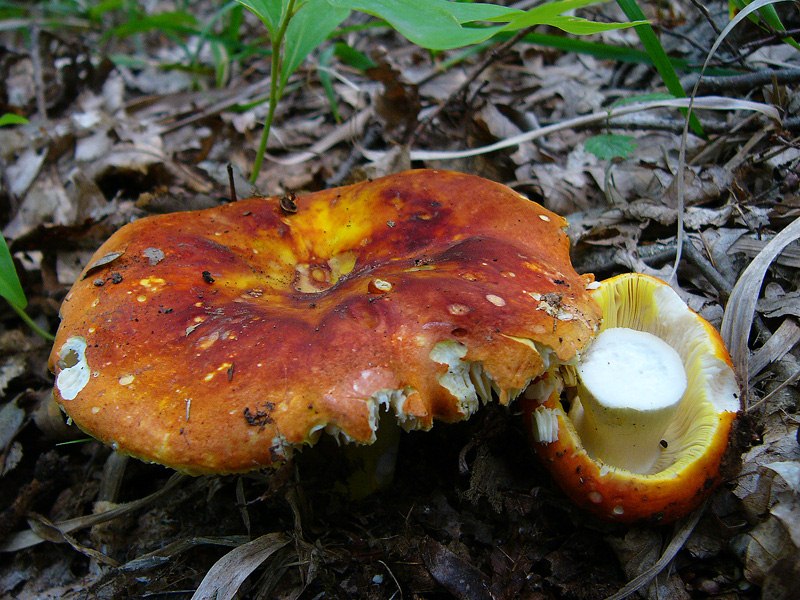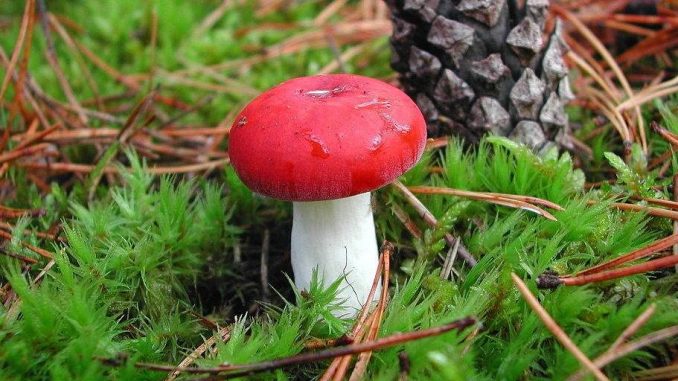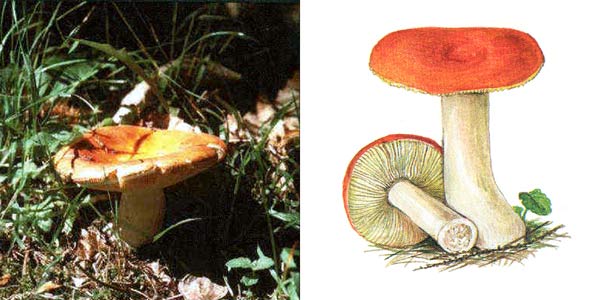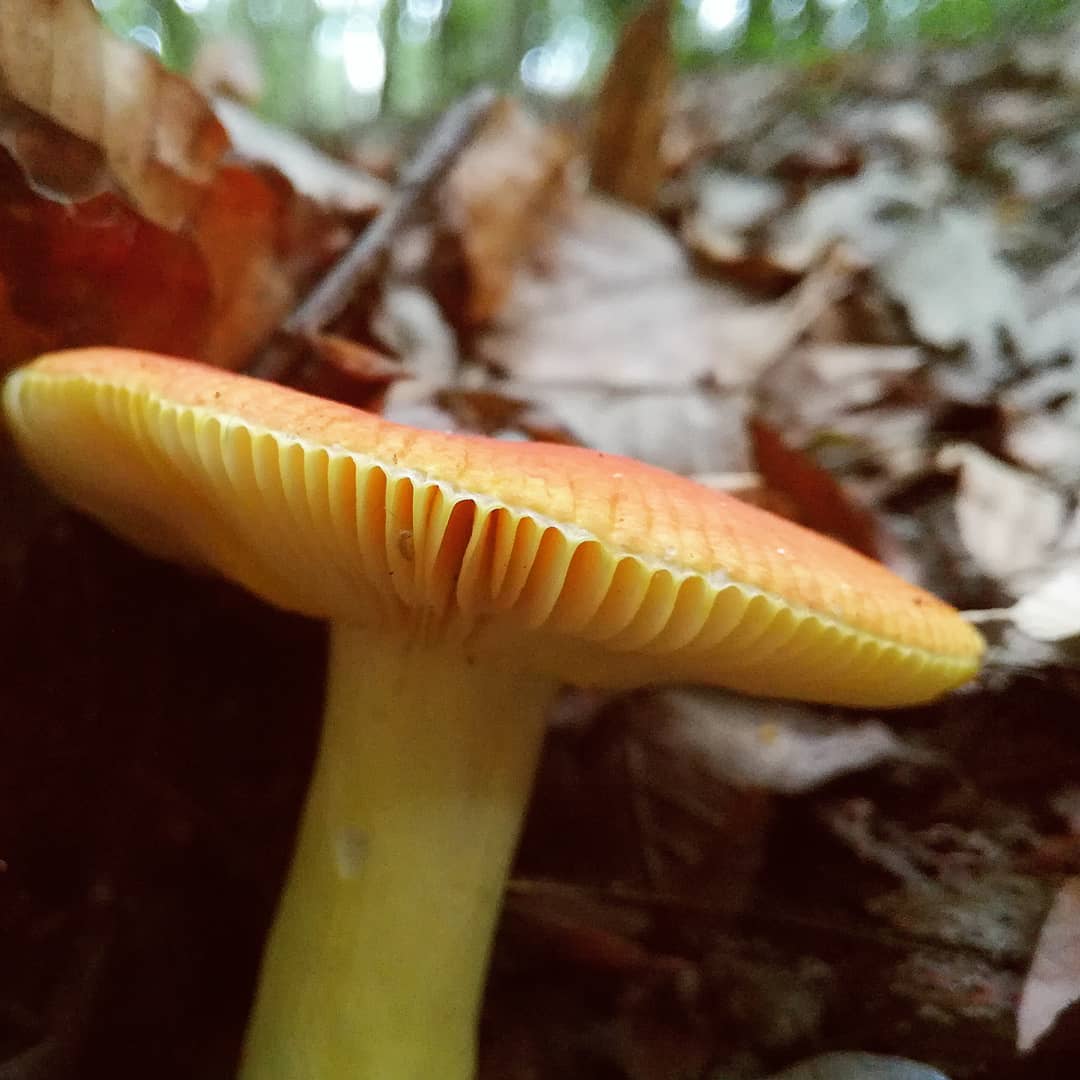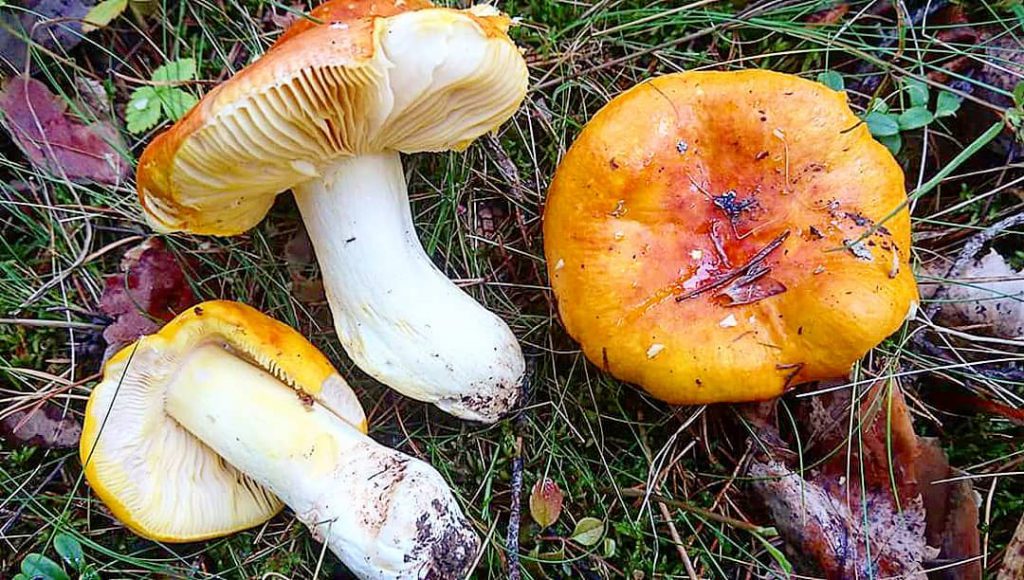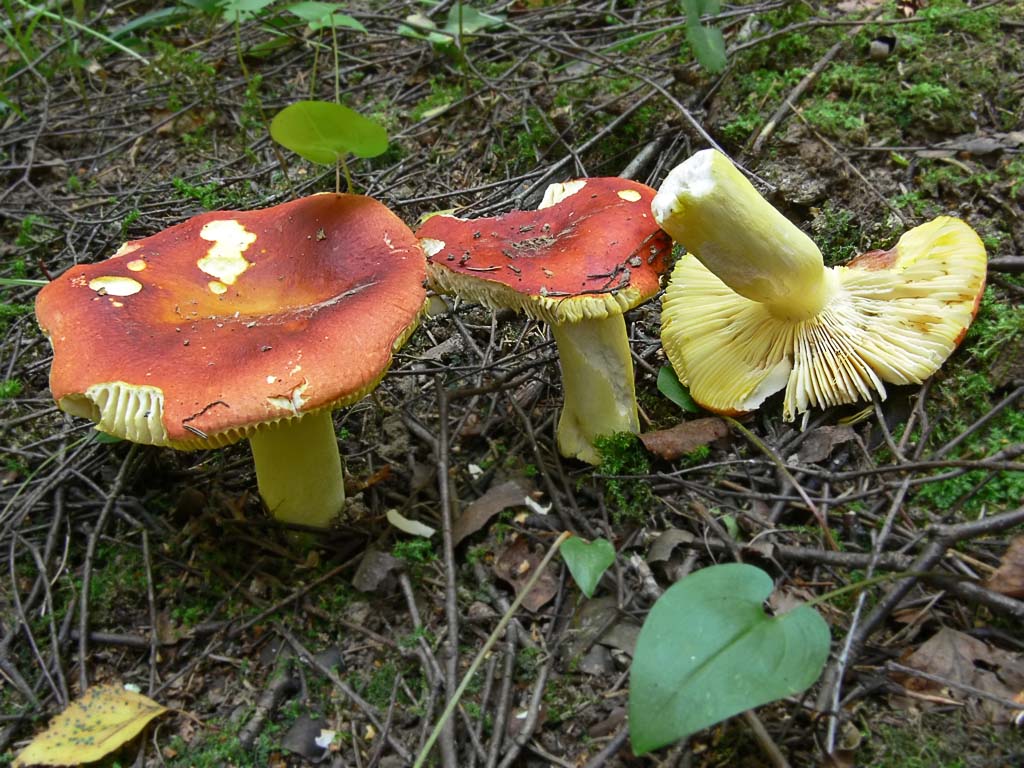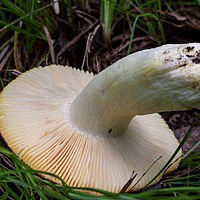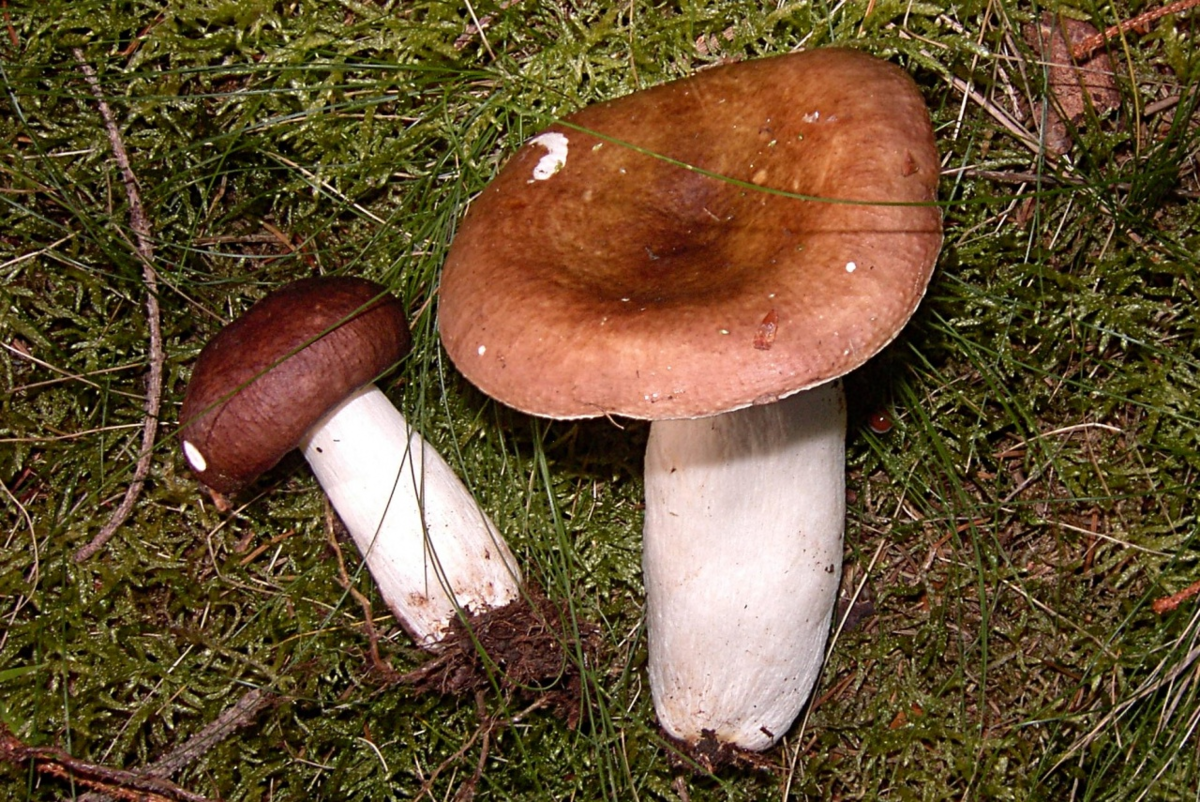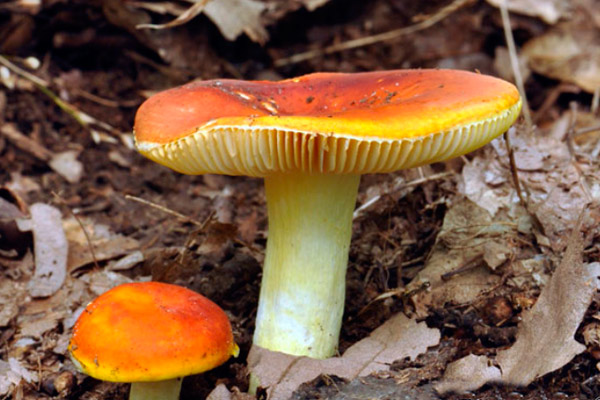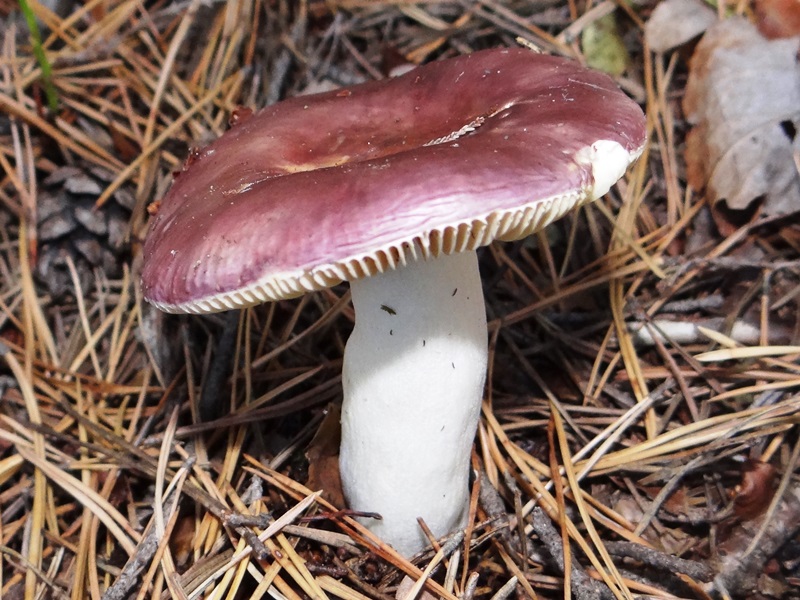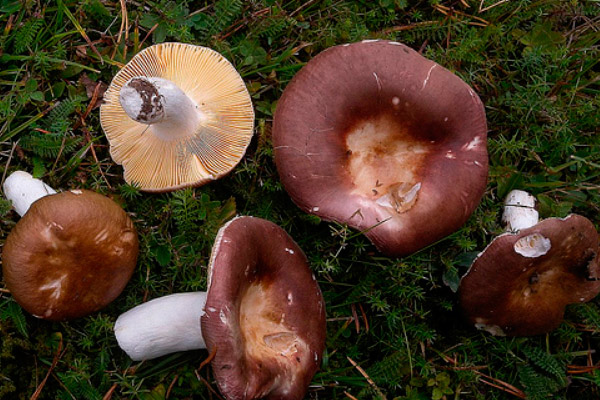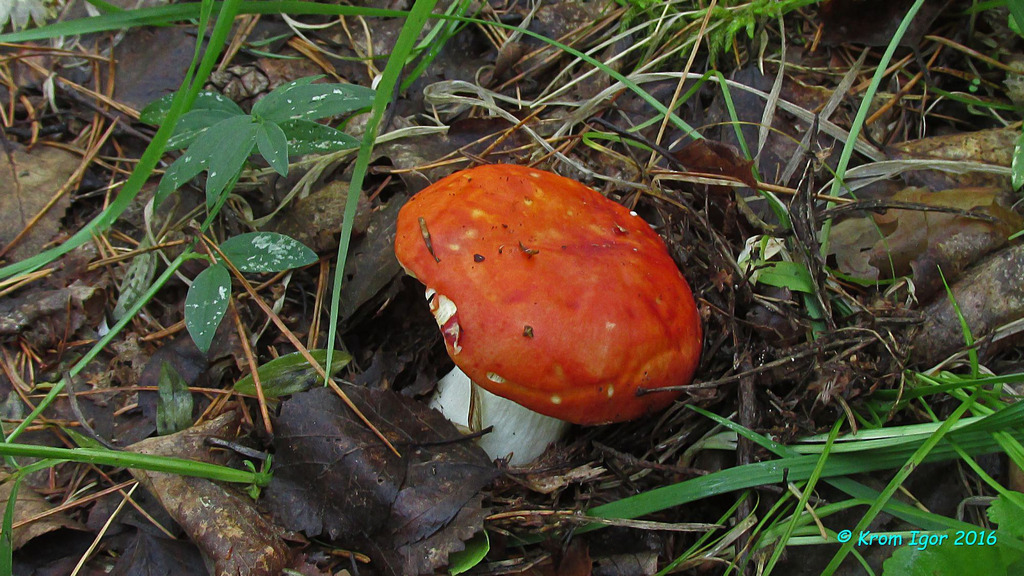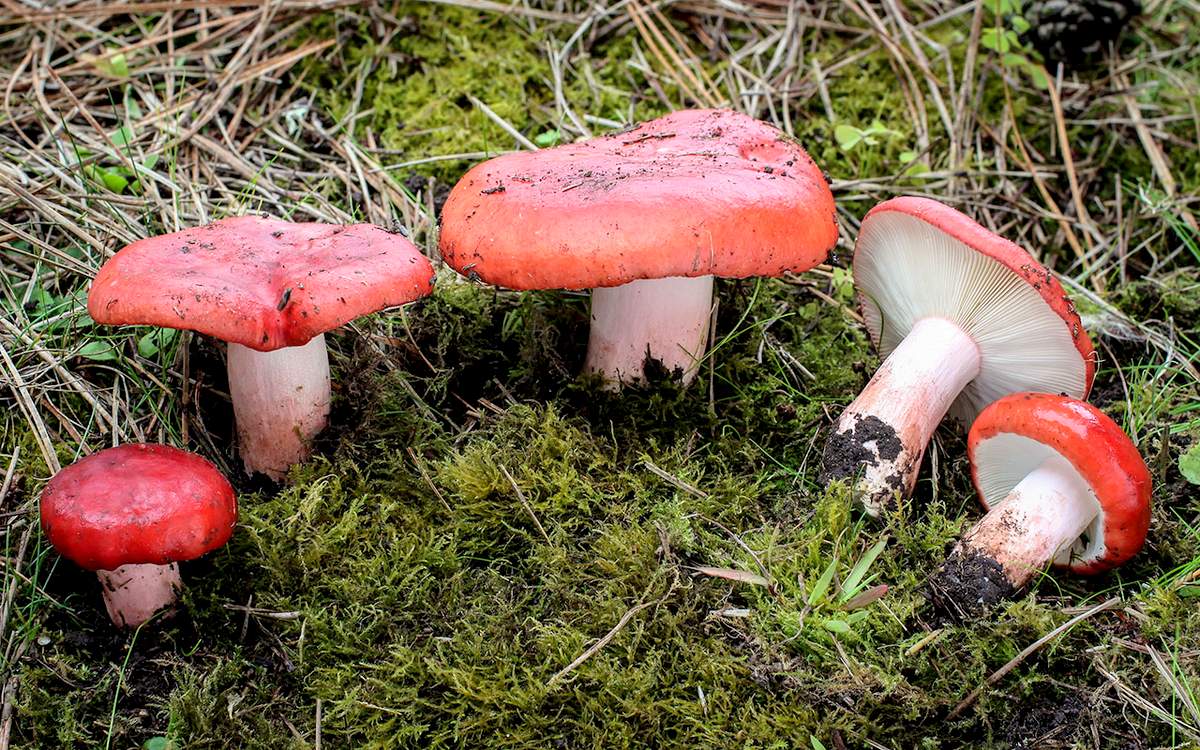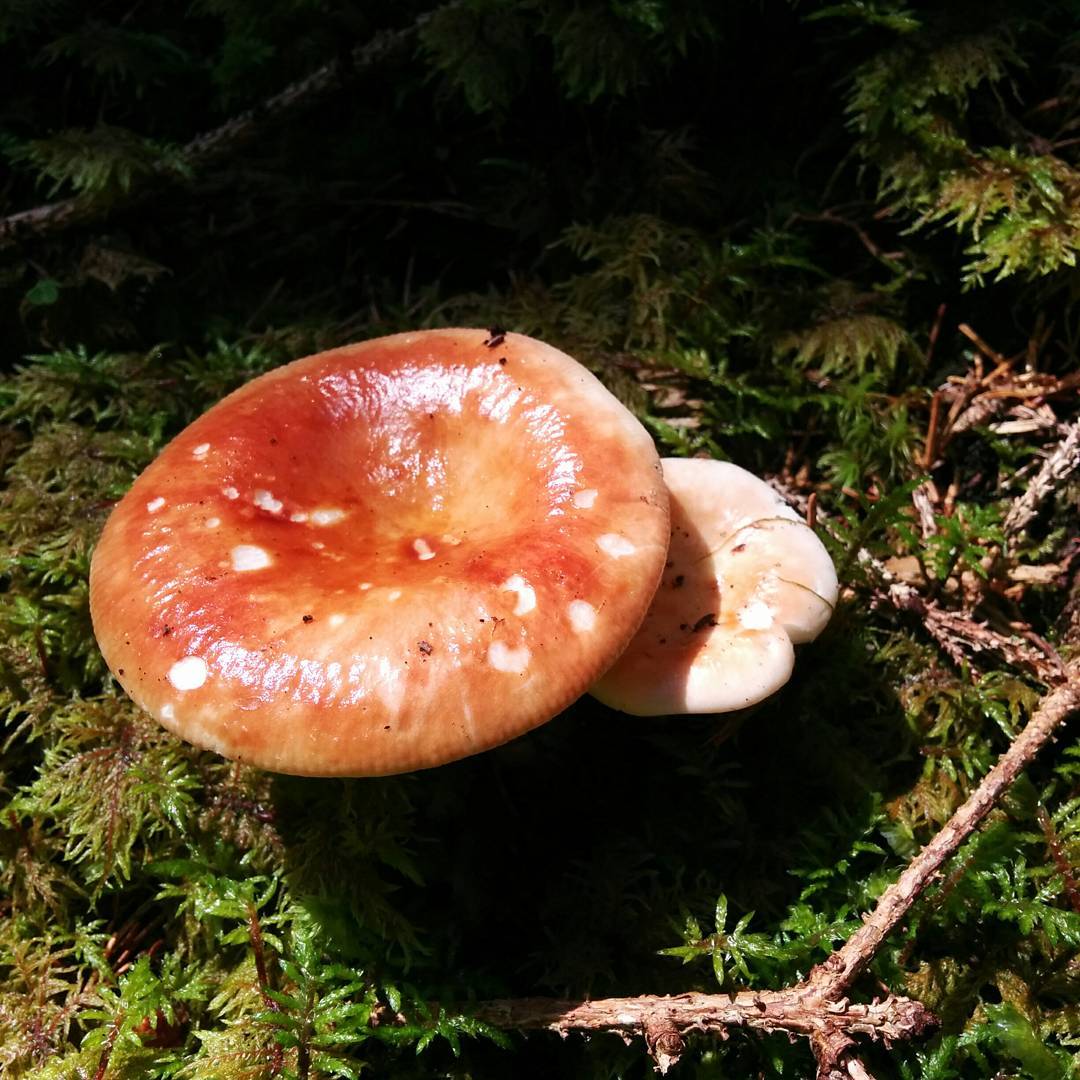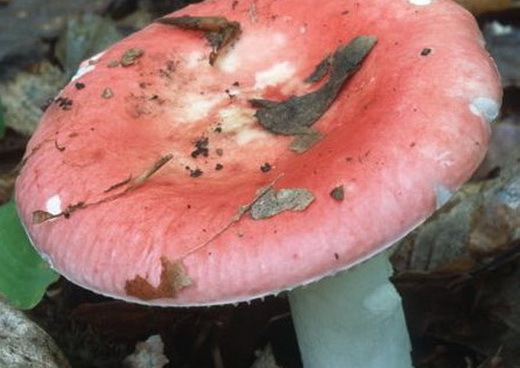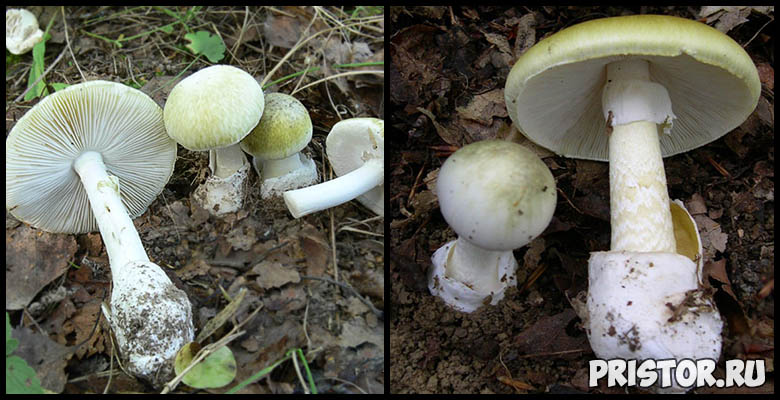Description of the blood-red russula.
Her hat is convex at a young age, and later becomes flattened. Its diameter is 3.5-10 centimeters. The color of the cap is blood-red, violet-red or wine-red. Often the caps fade, sometimes even become whitish.

There are quite frequent plates under the head. The plates are intertwined, descend a little on the leg. The color of the plates is first white and then cream.
The leg is cylindrical. Overripe specimens legs may become hollowbut they are not spongy. The shade at the stem is pink or wine red, often more intense at the base. The leg may turn yellow with age. Spores are ovoid, with a poorly visible mesh, warty. The spore powder has a light ocher color.

The pulp of the blood-red russula is strong. It tastes pungent or bitter, but sweetish in the leg. The pulp has a fruity smell. The color of the flesh is white, at the base of the leg it can be yellowish, under the skin it is reddish.

Ecology of blood-red russula.
Blood-red russula are numerous in North America and Europe, and the species is also known in Australia and South America. These mushrooms live mainly under the pines. They can grow in mixed forests and conifers. Occasionally they come across in open spaces. Blood-red russula settle on acidic and sandy soils. Fruiting occurs in August-September.

Varieties of edible russula
Science distinguishes only 275 species in the genus Russula. Of these, only 60 varieties grow in the CIS. Of the existing species, most of the mushrooms are edible. The most common of these are the yellow, gray, blue, green, food, fork and marsh varieties.
Yellow
This name is given to two types of russula: golden yellow and light yellow. The golden-yellow russula has a thin cap, convex at the first stages of growth, then depressed in the center. The color of the peel is yellow and its shades.
The golden variety is distinguished by a very fragile flesh of the cap and leg. The scent is similar to that of roses. The taste is sweetish, there is no bitterness. Grows in all types of forests.
Mushroom of light yellow variety is convex in shape. The hat is rich yellow, partly ocher. The pulp is firm, white, turning gray when cut. Mushrooms are slightly fragrant. The flesh is often sweet, sometimes with a speck.
Gray
Medium-sized mushroom with a fleshy head. The skin is gray, sometimes grayish green or pale gray. The pulp is dense, tasteless, white inside, but turns pink when cut. Has no pronounced aroma.
Blue
The russula of this species is also called azure. It grows mainly in coniferous plantings. It is found mainly near Norway spruce, with which it forms mycorrhiza. A distinctive feature is the blue color of the cap. The color varies from blue to dark lilac, sometimes uneven. The taste is pleasant, soft.
Green
Outwardly, the mushroom is unattractive. The skin of the cap is pale green or light marsh, from a distance it resembles the color of a toadstool. However, this mushroom is quite edible. The taste of the pulp is soft, even a little sweet. You can find a mushroom in any type of forest.
Food
One of the most valuable types of russula. The leg is straight, white. The hat is brown, but there are various color variations - from red-pink to gray. Occasionally, mushroom pickers come across a completely white food russula. The mushroom does not exude a clear aroma, but it has a pleasant taste, somewhat nutty. Found in all types of forests.
Forked
The second name of the species is multi-lamellar. The hat is different: yellow with a darker center, greenish or slightly brown. Conical leg, white. The plates are densely arranged, intertwined at the base, hence the name of the mushroom. The taste is sweetish, there is no bitterness. It grows under beech, hornbeam, oak and other broadleaf trees.
Swamp
This variety has a red cap, slightly brown in the middle. The color of the stem is often pale pink, sometimes pure white. The pulp is tasteless. The aroma is weak, fruity notes prevail. Swamp russula grow mainly under pine trees. They are also found in mixed forests.
Growing places
The red russula grows almost everywhere, but it is not recommended to collect it near highways. It perfectly accumulates harmful metals very easily. Therefore, in order to fill the basket with safe and useful specimens, it is better to go deeper into the forest.
The most successful places for finding and collecting red russula are pine and spruce forests. It is best to look for small islands of forest with high humidity near swamps, lakes and rivers. The largest harvests are traditionally harvested by residents of Western and Eastern Siberia. The harvesting season for red russula in these regions does not begin in August, but a little earlier, in mid-July. In coniferous forests, mushrooms of this type grow in open places. In most cases, russula brittle grow under thick branches, from which moisture is abundantly collected during the rain. Moss is preferred. If there is a lot of it, then it is likely to meet this mushroom in the vicinity.
In deciduous forests, russula fragile comes across in thickets of bushes and birch forests. If the terrain is uneven and has lowlands, then you can probably find a large number of mushrooms in them. If in coniferous forests they grow mainly singly, then in deciduous forests - in whole families. Although it can be very difficult to find such a family. They grow in glades, as well as in meadows, in tall grass.
It is correct to collect these mushrooms after rain and during a prolonged bad weather: then there are really a lot of them in the forest. In wet weather, picking is quite unpleasant, but it is during this period that the competition among mushroom pickers is noticeably reduced.
The russula is red or shiny found in deep forests, so it is very easy to get carried away and lose orientation when collecting. Traveling to unfamiliar places using a satellite map, you can outline the most likely locations of mushrooms, located in the ravines and lowlands. Experienced mushroom pickers do not go into an unfamiliar forest without a satellite navigator or at least a compass.
Most often russula grow in pine and spruce forests.
How to collect and prepare russula?
Collecting russula should be carried out only in baskets or enameled buckets. The plates of mushrooms are brittle, crumble quickly, so you cannot carry them in bags, backpacks, plastic bags and on the bottom of dishes under other mushrooms, where they break easily.
It doesn't matter if you cut the mushroom with a knife, twist it or just pull it: there will be no harm from this branched underground mycelium. The harvested "crop" cannot be stored for a long time, it must be processed as soon as possible
You can clean brittle russula after scalding or keeping in boiling water for 20 minutes, or by soaking the mushrooms in cold water for a while. During cleaning, you need to remove various twigs, needles, leaves and other forest debris, cut out darkened, as well as places eaten by worms and insects. From the caps of red russula, it is imperative to remove the skin, which is bitter. After cleaning, the mushrooms must be washed. The mushrooms are usually not washed before drying.

Silver russula (edible species). Photo by: Karelj, Public domain
Like other mushrooms, russula can be:
- fry,
- cook,
- salt,
- marinate,
- ferment,
- freeze for the winter.
Drying them is undesirable, due to the fact that many species have a bitter taste.
Pickled russula is a fairly tasty dish. To remove the bitterness before frying or boiling, it is advisable to soak the mushrooms for 10-12 hours, changing cold water 2-3 times. After that, they are rinsed and boiled for 5 minutes in lightly salted water. Then the mushrooms are placed in an enamel or glass container and poured with a solution prepared from water, salt and sugar, currant leaves are placed on top and, covering everything so that the brine comes out from above, left to ferment at a temperature of 20 ° C.In a month, fermented russula will be ready.
For the subsequent preparation of dishes, you need to cook russula for at least 30 minutes, salt, add spices and periodically remove the resulting foam. Then they need to be thrown into a colander. If the conditionally edible russula is bitter, during cooking, the bitterness will go into the water, which you simply drain. You can fry boiled, soaked and not even soaked russula: the main thing is that they do not have a burning or bitter taste. While frying, you can add onions, spices, lemon juice, garlic, and other ingredients.
Russula are salted and pickled in the same way as other mushrooms. Moreover, unlike other mushrooms, russula can be salted in a day and even faster. After cleaning and a short soaking, the mushrooms are transferred to an enamel bowl, salt, garlic and spices are added to your taste, covered with a lid and left for at least 12 hours. After this time, russula can be eaten.
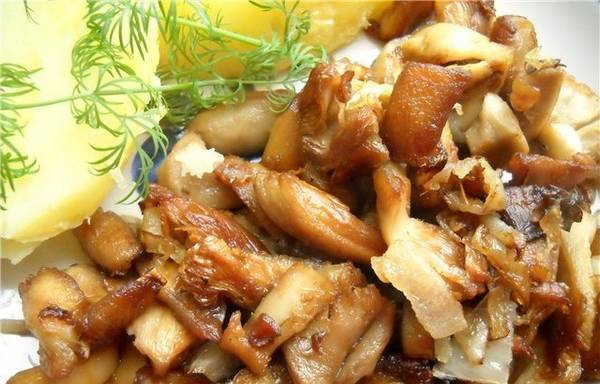
Taken from the site.
Russula golden - description, where it grows, the toxicity of the mushroom
It is worth noting an interesting fact that the fruit bodies in question are one of the most popular mushrooms. Russula are common all over the world. In addition, such specimens are very easy to assemble. Due to the bright and memorable color, such fruits can be found without problems in wooded areas. Almost all representatives of this species have a pleasant taste and aroma. Therefore, they are highly valued in the culinary world.
Description
- Fruiting bodies may have a cap no more than 12 cm in diameter. If we take into account young specimens, then they have a convex shape. Only over time does the cap become open. You can often see a depression in the center. The edges become ribbed.
- The surface of young fruiting bodies is glossy and smooth. You may also notice that it is covered in mucus. The color of the cap is almost always brick red. Older fruits have a matte and velvety surface. Their color is often ocher-yellow or orange with reddish spots.
- As for the general structure of the fruiting body, the pulp is crumbly and brittle. In most cases, it has a whitish tint. At the same time, after cutting the mushrooms, the color does not change in any way. Under the cap there are frequent plates that fit tightly to the leg. They are rounded to the edges of the cap.
Spreading
- The fruit bodies in question often grow in forests with old oaks, beech, hazelnuts, spruces and aspens. Linden, elm and similar broadleaf trees can also be found in such woodlands.
- In most cases, such specimens prefer to choose calcareous soil. The fruiting season is mid-summer. It ends in the middle of autumn. Instances can be found singly or in small groups.
Virulence
Mushrooms are edible. However, such specimens, in comparison with relatives, cannot boast of high taste and a bright rich mushroom aroma. This applies to raw fruits. When cooked, mushrooms acquire a completely different, rather good taste and aroma.
Similar species
- The morse russula is similar to the fruit bodies under discussion. Such an instance belongs to edible mushrooms. The hat of such a russula in diameter can reach up to 12 cm. Separately, it is worth noting the fact that in young fruiting bodies, the cap looks like a ball.
- Over time, it takes on the shape of a bell. Old fruiting bodies can already be seen with a flat cap. There is also an old skin on it, while it separates from the pulp without any problems. The hat is often yellow-brown. The leg has a dense structure and a white color. It is rare to see spots on it.
- In most cases, the legs of such mushrooms are almost even, only sometimes they thicken closer to the ground. These russula can often be found in Russian forests. It is this type of fruiting bodies that account for about 48% of all other fruits.
- In most cases, mushrooms are salted. The problem is that they taste rather bitter.Therefore, before salting, they must be soaked and get rid of the skin from the cap.
- There is also another species that is similar to our mushrooms. The fragile russula is considered a conditionally edible fruiting body. It is small in size. The diameter of its cap can be up to a maximum of 6 cm. Most often it is painted in a pinkish-purple hue. In young specimens, the cap is initially convex.
Golden russules are quite common all over the world. As for the collection of such fruiting bodies, then you should not have any problems with this. The distribution of these copies is quite extensive. After cooking, the mushrooms acquire excellent taste and pleasant aroma.
Positive properties
Of the positive qualities of russula with red brittleness, it can be noted that it is very difficult to confuse it with poisonous mushrooms, for example, with pale toadstool. Other types of russula are often confused with toadstools, with severe poisoning.
The red russula contains a large amount of vitamins B1, B2, C, E and A. These vitamins are perfectly preserved in pickled mushrooms. It also contains useful minerals: magnesium, calcium, iron, potassium and other useful substances.
The red russula has a very interesting taste. It tastes pungent when raw and is not edible. It is not recommended to use it for frying. But for pickling, you cannot find the best mushroom - the taste is spicy, piquant and memorable. To obtain the excellent taste of pickled russula, it is not recommended to mix them with other species. To do this, you will have to go to the forest exclusively for this species. As for salting, there are no restrictions. They are salted well with other mushrooms.
Basement (Russula subfoetens)
Synonyms:
- Russula foetens var. subfoetens
- Russula foetens var. minor
- Russula subfoetens var. johannis
Description
Hat: 4-12 (up to 16) cm in diameter, spherical in youth, then prostrate with a lowered edge, with a wide, but insignificant, depression in the center. The edge of the cap is ribbed, but the ribbing appears with age, with the opening of the cap. The color is pale yellow, yellow-brown, honey shades, in the center to red-brown, without gray shades anywhere. The surface of the cap is smooth, slimy, sticky in wet weather.
Flesh: White. Unpleasant odor associated with rancid oil. Taste from not pronounced to quite spicy. A basement with a non-spicy taste is considered a subspecies - Russula subfoetens var... grata (not to be confused with Russula grata)
Plates from medium frequency to frequent, adherent, possibly notched-adherent, possibly with a slight descent to the pedicle. The color of the plates is white, then creamy, or creamy with yellowness, there may be brown spots. Shortened plates are rare.
Spore powder, cream. Spores are ellipsoidal, warty, 7-9.5 x 6-7.5μm, warts up to 0.8μm.
The leg is 5-8 (up to 10) cm high, (1) 1.5-2.5 cm in diameter, cylindrical, white, aged with brown spots, with cavities, inside which are brownish or brown. The stem turns yellow when KOH is applied.
The stem may have a brown pigment hidden under a whitish layer that appears reddened if KOH is applied to such a place.
Habitat
Occurs from late June to October. Usually bears fruit in large quantities, especially at the beginning of fruiting. Prefers deciduous and mixed forests with birch, aspen, oak, beech. Found in spruce forests with moss or grass. In spruce forests, it is usually more slender and slightly colored than in forests with deciduous trees.
Similar species
There are many value russules in nature, I will describe the main part of them.
- Valui (Russula foetens). The mushroom, in appearance, is practically indistinguishable. Formally, value is more meaty, more smelly, and more pungent in taste. The only clear difference between the basement and the valuy is the yellowing of the stem when potassium hydroxide (KOH) is applied. But, it is not scary to confuse them, they, after cooking, are also indistinguishable, at all.
- Powdery russula (Russula farinipes). Differs in a fruity (sweetish) smell.
- Buffy russula (Russula ochroleuca). It differs in the absence of a pronounced odor, less pronounced ribbing of the edge, thinner flesh, the absence of brown spots on the plates and legs of age fungi, and, in general, looks more "russule", not particularly similar to the value, and, accordingly, the basement.
- Russula pectinata (Russula pectinata). It has a fishy odor and a mild taste (but this is not a difference from Russula subfoetens var. Grata), usually has grayish tints in the cap, which may not be noticeable.
- Almond russula (Russula grata, R. laurocerasi); Russula fragrantissima. These two species have a pronounced almond scent.
- Russula Morse (S. unwashed, Russula illota) Differs in almond smell, dirty grayish or dirty violet shades on the cap, dark edging of the edge of the plates.
- Russula pectinatoides; Russula praetervisa; Russula sororia; Russula recondita; Russula amoenolens; Russula insignis; Russula pseudopectinatoides; Russula cerolens. These species are distinguished by gray tones of the color of the cap. There are other, different, differences, but the color is enough for them.
- Russula pallescens. Grows in pine forests, not intersecting with the basement in the biotope, lighter shades, extremely sharp, small in size, thin-fleshed.
Edibility
Conditionally edible mushroom. Very good in salting, or fermented, if harvested, until the edges of the cap have moved away from the stem, after soaking for three days with a daily change of water.
Mycelium Golden-red Russula (Russula golden), Russula aurata
Description
Russula golden-red (Russula golden), lat. Russula aurata is a mushroom of the genus Russula (Russula) of the family Russulaceae. The mushroom is lamellar, has a pronounced cap and leg. The cap of young bell-shaped mushrooms, later becomes completely flat, with small depressions. The surface is free of mucus, the skin is well separated from the pulp. Plates are even, often located, ocher color. In many specimens, the edges of the plates have a bright yellow color. The color of the cap itself can be different - yellow, brick, red, with a purple tint. The leg of a russula of this type is dense, numerous scales are located on the surface. The color is creamy, in older mushrooms it can be brown. The structure of the pulp is dense, odorless, tastes slightly sweet. There is no bitterness. The lumpy spores of Russula aurata have ribs that form a mesh. The growing area is very large, the fungus is found everywhere in the forests of Europe, Asia, and North America. It prefers to grow in small groups. Perfectly cultivated! Our mycelium is intended for sowing mushrooms at home, healthy, high quality, has good germination!
There are two types of mycelium of forest mushrooms: 1. Mycelium (mycelium) live fresh primary grain packed in a transparent blister / zipper measuring 8x12x3cm and weighing 120-150 grams (depending on the humidity of the environment; after all, it is alive, develops, breathes, gains and loses moisture). Shelf life is 6 months. at a temperature of + 2 + 6 ° С or 1 month at temperatures up to + 23 ° С without direct sunlight. It can withstand a higher temperature for 10 - 14 days, if the packages are not tightly in contact with each other. 2. Mycelium (mycelium) biologically dried primary grain 100g in a transparent blister / zipper package 8x12x3cm. The shelf life is not limited.
INSTRUCTIONS FOR CULTIVATION OF FOREST MUSHROOMS Planted in gardens, parks, forests, nurseries, greenhouses, flower beds, lawns, etc. area 2.5 - 3m2. Fluff the ground under the tree so that a depression of 5 - 15 cm is formed, depending on the location of the roots at the soil surface. Spread the mycelium evenly over the entire fluffed surface. Cover with garden (or forest) soil, mixed with any humus, in equal parts. Sprinkle on top with the soil that was formed during fluffing with a deepening. Planting can be done at any time of the year and under any species of trees. Watering is carried out in dry times, often with a garden watering can or in another way, about 10 liters per 1 m2. Mushrooms appear in spring and autumn, but for the first time not earlier than 5 months after planting.Sometimes the first harvest can be only the next year. The first harvest is 350 - 500 g / m2, the next 3.5 - 4.5 kg / m2. Mycelium grows for many years, as long as the tree lives. All forest mushrooms can be planted together with tree seedlings. Spread the mycelium, for example, russula or milk mushrooms, well, or any others, evenly over the bottom of the hole prepared for planting a seedling, and then continue planting plants as usual. It is recommended to grow a chanterelle next to any forest mushrooms! Chanterelle is widely used both in folk medicine and in traditional official pharmacology. This mushroom contains many substances that not only determine its medicinal properties, but also actively fight against fungal diseases, harmful molds that interfere with the normal development of mycelium, mushroom worms, etc. Chanterelles themselves almost never worm themselves (there is one type of worms that eat them, but I personally have never seen them) and nearby mushrooms can grow to gigantic sizes without worming either. The mycelium of the chanterelle, as it were, “prepares” the place for the development of the mycelium of the titular fungus, and then zealously “takes care of” it for many years. Next to the chanterelles, porcini mushrooms, boletus mushrooms, aspen mushrooms, Polish mushrooms, boletus, like everyone else, feel great!
Indoors, you can try to grow mushrooms in the same way as champignons, only by sowing any perennial grass. The results of growing will be slightly worse than in an open area, but it is really possible. More detailed instructions (+ instructions for growing and other mushrooms by species) in the brochure will be sent along with the order. Free consultations after the sale before the appearance of the first mushrooms when ordering from 5 packs. Mycelium will be sent after partial or full payment. With 100% payment - a bonus from the manufacturer!
Russula golden
| Group: | Lamellar |
|---|---|
| Plates: | White, yellowish |
| Colour: | Shades of red |
| Info: | Scales on the leg |
| Department: | Basidiomycota (Basidiomycetes) |
|---|---|
| Subdivision: | Agaricomycotina (Agaricomycetes) |
| Class: | Agaricomycetes (Agaricomycetes) |
| Subclass: | Incertae sedis (indefinite) |
| Order: | Russulales |
| Family: | Russulaceae (russula) |
| Genus: | Russula (Russula) |
| View: | Russula aurea (Russula golden) |
The mushroom is edible, assigned to the 3rd category, has a pleasant taste. It is appreciated above most types of russula. You can use it fresh or salted.
Description
Russula golden received its specific name due to the clear yellow subtone of the color of the entire fruit body.
Hat
The size of the cap varies from 4 to 9 cm in diameter. With maturation, its shape changes from hemispherical to flat and then centrally depressed. Young specimens have smooth edges, and old ones are striated (a layer of hymenophore appears).
The color of the cap is of all shades of red, and at a young age, red color predominates in mushrooms of this species, and yellowness appears more and more in maturity. The central cap is almost always colored in shades of yellow. The surface is variable to the touch depending on humidity: in the absence of precipitation - dry, in rainy weather - sticky.
Leg
The russula golden has an even-cylindrical stem with a rough-scaly surface. The leg is painted white, sometimes yellowish, and turns brown in mature mushrooms. Inside, the leg never contains a cavity and has a cotton-like consistency. In mature mushrooms, it acquires a distinct porosity. The dimensions of the leg are from 3 to 8 cm in height and from 1 to 2 cm in thickness.
Spore powder
The spores are egg-shaped and fairly large. Their surface is bumpy and reticulate. The bulk of the spore powder is white.
Spore-bearing layer
The plates are of moderate thickness, can be located both often and not very much. Multiple bifurcation of the plates is usually observed. Their color is initially white, but in the process of maturation it quickly turns yellow. The plates are not attached to the leg.
Pulp
Initially hard and crumbly, in mature specimens it becomes softened and “wadded”. Directly under the easily detachable skin of the cap, the flesh is yellow, and in the rest of the mushroom it is white. The pulp does not emit any smell and has a pleasant sweet taste.
Distribution and collection
The golden russula, with a fairly widespread prevalence (practically over the entire Eurasian and North American territory), is not very common. This species grows mainly in deciduous forests all summer and the first month of autumn.
Similar species
There are several types of russula, resembling golden in appearance:
This mushroom has a very strong pulp and red shades of the cap, which do not turn yellow with age. The pulp has a distinctly fruity smell, and when heat-treated it is turpentine, and therefore the species is not considered edible. This species is found in all types of forests.
On the cut, it changes color to gray, grows more often in swampy areas, is edible.
Buffy russula
It is similar to the previous one (yellow), but higher in gastronomic quality, does not turn gray on the cut and grows in dry places.
Russula golden yellow
It is edible and smells like flowers, this smell is enhanced by heat treatment. The mushroom has a bright yellow coloration of the plates and a cap without redness.
Russula solar
Inedible, has a yellow cap without redness. The taste of this mushroom is pungent, and the smell is mustard. It is usually found next to oak trees.
Acetic russula
It has a red cap and emits a pronounced vinegar smell, its edibility is controversial.
Edibility
The golden russula is edible and delicious. It is sweetish and does not have foreign odors, which makes it suitable for use in any mushroom dishes.
Interesting Facts
Like the rest of the russula, the golden russula should not be eaten raw. The name does not reflect this aspect at all, but the fact that these mushrooms take much less time to cook than other mushrooms.
It is found infrequently (although almost everywhere) and is a rather successful find due to its good taste. It can be confused with some inedible russula species, so you should focus on specific distinctive features.
The benefits of golden yellow russula.
Due to the rich composition of golden-yellow russules, they are very useful for the body. They contain vitamins B1 and B2, E, C and PP. They also contain lecithin, which normalizes blood cholesterol levels.
The enzyme trasulin was also found in russula. This unique substance has recently been found in russula. It helps to curdle milk, the resulting fermented milk product is very useful. Russulas help to rid the body of toxins, while enriching it with vitamins.
Thanks to this, the golden yellow russula are popular with dieters. The russules are nourishing and do not leave a feeling of discomfort in the stomach.
Russulas help get rid of dead skin on the legs and corns. To do this, rub russula juice into problem areas, after which the skin becomes soft and tender.
Harm of golden yellow russules.
The russula are golden yellow, despite the low calorie content, it is rather difficult for the body to assimilate. For these reasons, people with stomach and heart problems should refrain from these mushrooms. It is dangerous for children to give any mushrooms, including russula. You should consume no more than 150 grams of russula per day.

Related species of golden yellow russula.
Whole russula is an edible relative of the golden yellow russula. Its cap has a hemispherical or outstretched shape. The color of its cap can be brownish or olive yellow. Its surface is slimy. The edges are wavy. The pulp is brittle, with a sweetish taste and a bitter aftertaste. The color of the pulp is white. The leg is white with a pink bloom with yellow spots at the base.
Whole russula grow in coniferous forests. They settle in calcareous soil. They bear fruit in groups. They are collected from July to October.
Blue russula is another edible species.The cap is fleshy, convex or depressed. The skin is easily separated from the cap. The pulp is relatively strong, odorless, not pungent, white in color. The leg is solid, strong in youth, and then hollow. The color of the leg is white.
Blue russula grow in coniferous forests, mainly in spruce forests. This species is found in the European part of our country and in the Baltic States. Most often it grows in groups. Fruiting occurs from August to September.
Description
- Fruiting bodies may have a cap no more than 12 cm in diameter. If we take into account young specimens, then they have a convex shape. Only over time does the cap become open. You can often see a depression in the center. The edges become ribbed.
- The surface of young fruiting bodies is glossy and smooth. You may also notice that it is covered in mucus. The color of the cap is almost always brick red. Older fruits have a matte and velvety surface. Their color is often ocher-yellow or orange with reddish spots.
- As for the general structure of the fruiting body, the pulp is crumbly and brittle. In most cases, it has a whitish tint. At the same time, after cutting the mushrooms, the color does not change in any way. Under the cap there are frequent plates that fit tightly to the leg. They are rounded to the edges of the cap.
Russula yellow
Russula claroflava, aka yellow russula grows in swampy ground under birch and aspen. Has pale buffy yellow gills. It is almost impossible to confuse this fragile mushroom with any other member of the russula genus. The requirements of the yellow russula for the habitat are moist soil under the birch. The clear yellow cap and flesh slowly turn gray when cut - these are distinct features.
p, blockquote 1,0,0,0,0 ->
Habitat of yellow russula
The fungus is widespread in humid forests where birches grow, it is found in the northern and central parts of mainland Europe, in North America on the northwestern Pacific coast. It is mainly a summer-autumn mushroom, but sometimes it appears in spring.
p, blockquote 2,0,0,0,0 ->
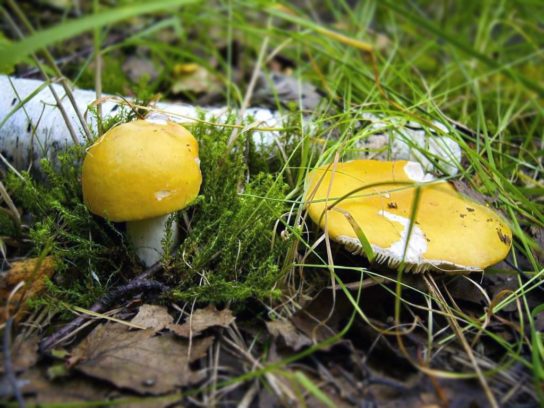
p, blockquote 3,0,1,0,0 ->
Taxonomic history
The fungus was described in 1888 by the British mycologist William Bywater Grove (1838–1948), who gave it the binomial scientific name Russula claroflava, which mycologists still use to describe this genus.
p, blockquote 4,0,0,0,0 ->
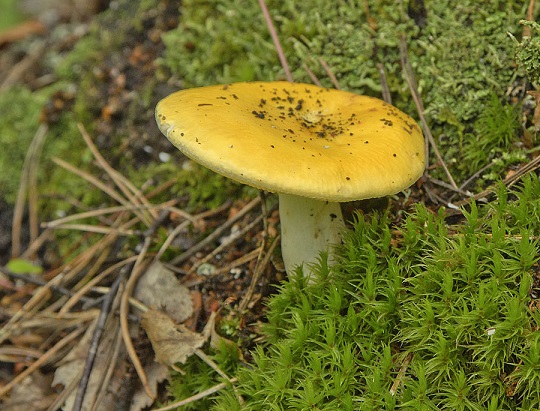
p, blockquote 5,0,0,0,0 ->
Hat
Diameter from 4 to 10 cm, the cap is convex at first, then flattened, often the center is slightly depressed. Bright yellow, sometimes ocher yellow, the surface is smooth when dry and sticky when wet. The cuticle exfoliates halfway to the center, the flesh under the cuticle is white, slowly turning gray in places of cut or break.
p, blockquote 6,0,0,0,0 ->
Gills
The plates of the hymenophore are attached to the stem, sometimes not, rather numerous, the bifurcated gills are pale buffy, gradually darkening as the fruiting body ages.
p, blockquote 7,1,0,0,0 ->
Leg
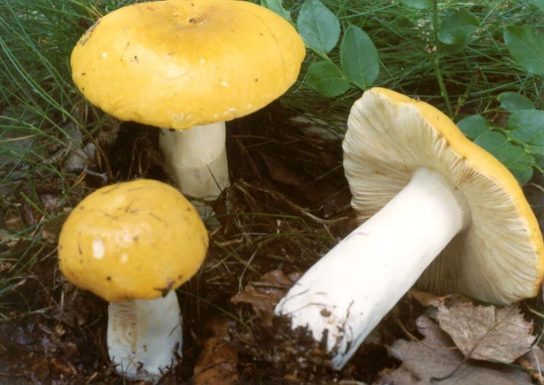
p, blockquote 8,0,0,0,0 ->
10 to 20 mm in diameter and 4 to 10 cm in height, fragile legs are white at first, then turn gray with age or when damaged. The flesh is also white and there is no ring on the stem.
p, blockquote 9,0,0,0,0 ->
Spores are ellipsoidal, 8-9.5 x 6.5-8 microns, decorated with blunt, predominantly isolated warts up to 0.6 microns in height with only a few connecting filaments. The spore seal is pale ocher yellow. No significant odor, mild or slightly pungent taste.
p, blockquote 10,0,0,0,0 ->
The ecological role of russula yellow
This is an ectomycorrhizal fungus that creates a symbiotic relationship with birches and aspens, participates in metabolic processes in the forest, decomposes fallen leaves and needles, and delivers nutrients to the roots of trees.
p, blockquote 11,0,0,1,0 ->
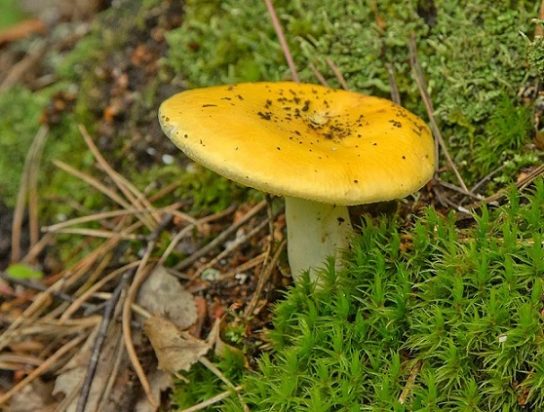
p, blockquote 12,0,0,0,0 ->
Similar species
The russula is buffy. She has an ocher-yellow cap, often greenish in the middle, bitter flesh, burning mucous membranes. A conditionally edible mushroom will cause gastrointestinal upset if not cooked properly.
p, blockquote 13,0,0,0,0 ->
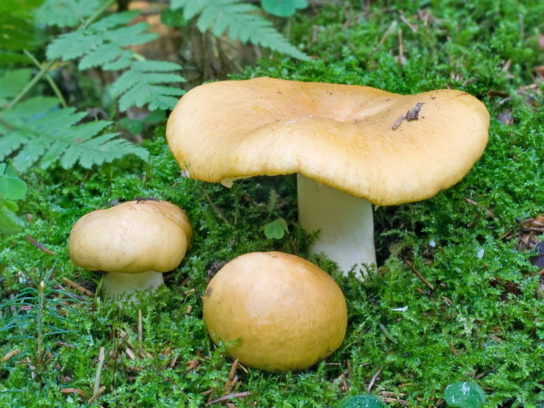
Culinary benefits of yellow russula
There are russula in a moist moss forest under birches, where the soil is quite hard and not viscous. Mushroom pickers collect this edible mushroom with a pleasant taste and texture, fried with onions and garlic. Yellow russula are highly valued by people who eat wild mushrooms, serve with meat dishes, make delicious fillings for omelet, or, of course, use them in mushroom soups or stews.
p, blockquote 14,0,0,0,0 ->
Poisonous mushrooms similar to yellow russula (false)
Mushroom pickers without experience confuse it with toadstool-like fly agaric. The poisonous mushroom has white flakes on the cap, a stem with a green ring and a fringe.

